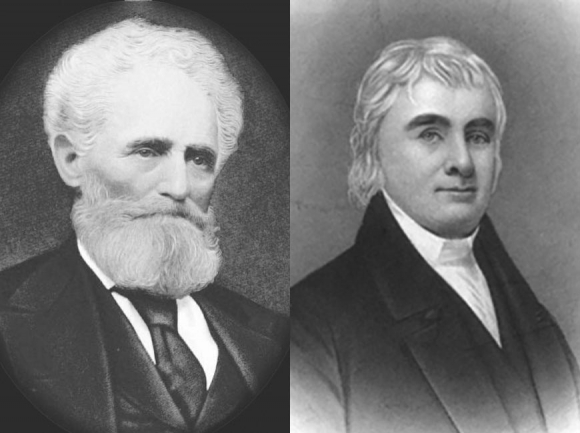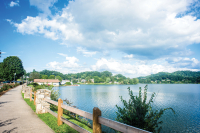Entwined with slavery: A brief local history
 Nicholas W. Woodfin (left) and John Haywood.
Nicholas W. Woodfin (left) and John Haywood.
By Peter H. Lewis • AVL Watchdog | By 1860, about 15 percent of the population of Western North Carolina was enslaved. Only a small percentage of the White settlers, who had pushed out Indigenous Native Americans, owned slaves — about 2 percent of households, according to Katherine Calhoun Cutshall, collections manager, North Carolina Room, Pack Memorial Library — and of those, most owned one or two. The majority were owned by a handful of elite families, whose names are commemorated throughout the region.
They used their wealth and influence to help build Asheville and surrounding communities, supporting government, schools, healthcare, infrastructure, parks and other civic improvements, for which they were honored. But the wealth that lifted them to prominence was derived in large part by the enslavement and exploitation of Black people, entwining their many good deeds with the evil of racism.
Asheville
Originally Morristown, the town was incorporated and renamed in 1797 to honor Samuel Ashe (1725-1813), governor of North Carolina and a major slaveowner. He never lived here. Asheland Avenue is also named for him.
The Patton family constituted the largest slaveholders in Asheville, collectively owning more than 220. James W. Patton (1803-1861) owned 78 in 1860 and was, with J.E. Patton and others, active in buying, selling and trading hundreds of enslaved Blacks. Patton Avenue is named for him. John Patton and Samuel Chunn were partners in a slave-trading business. Chunn has a road and a neighborhood named for him.
Asheville businessman and hotelkeeper James McConnell Smith (1787-1856) owned 75 enslaved Blacks, some of whom built the Smith-McDowell House, believed to be Asheville’s oldest surviving structure. It is now headquarters of the Western North Carolina Heritage Center. William McDowell owned 40 slaves.
Related Items
Daniel Reynolds (1809-1878), namesake of Reynolds Mountain, owned 15 slaves.
Asheville’s first merchants, brothers Zebulon and Bedent Baird, owned 14 slaves in 1820. The Baird family (Baird Cove Road) owned 36 slaves.
Augustus Summerfield Merrimon (1830-1892), U.S. Senator and Chief Justice of the North Carolina Supreme Court, wrote, “Slavery has certainly existed from the earliest times down to the present, and it would seem that it is, in one sense, of divine appointment … I am thoroughly convinced that Slavery in this country cannot be abolished without greatly endangering our country … If it is an evil in the abstract, it would be a greater evil to abolish it here.” Merrimon Avenue is named for him.
Asheville’s hotel and tourism industry, already thriving before the Civil War, was in large part based on slave labor.
Buncombe County
Originally the State of Buncombe, which encompassed much of western North Carolina, it was named after Col. Edward Buncombe (1742-1778), who forced more than 100 enslaved Africans to work his sugar plantations.
In the 1860 census the Black population of Buncombe County was 13 percent, but historians note the percentage swelled in summer months as slaveholders in Georgia and South Carolina temporarily moved their families to mountain resorts.
In 1860 Zebulon Vance owned six Blacks; his brother owned seven.
William Johnston, a farmer, owned 55 slaves.
Weaverville
In 1860, U.S. census data show that the families of Michael Montraville Weaver and his wife Jane Eliza Baird Weaver, who donated the land of what is today Weaverville, collectively owned 93 enslaved people.
Woodfin
The town was named for Nicholas W. Woodfin (1810-1876), a “complicated” man who “was at best inconsistent in the application of his values,” according to the Town of Woodfin Facebook page. By 1860 Woodfin was western North Carolina’s second-largest individual slaveholder, owning 122 enslaved people. Only William F. McKesson in Burke County personally owned more, 174.
Haywood County
Named for John Haywood, state treasurer for 40 years. After his death in 1827 auditors discovered $68,906.80 missing (equivalent to $1.86 million in 2020 dollars). His enslaved Blacks were sold to partially reimburse the state. His namesake county, however, had relatively few enslaved people in 1860; the exception was James Robert Love, proprietor of the White Sulphur Springs Resort near Waynesville, who owned 85 servants.
Madison County
Originally inhabited by the Cherokee people, Madison County was named for James Madison (1751-1836), fourth President of the United States, who owned more than 100 slaves on his Virginia plantation and sold them for personal profit.
The Black population of Madison County in 1860 was 3.6 percent.
According to a Sept. 2, 1903, article in The Laurens (S.C.) Advertiser, African Americans were not allowed to live in Madison County except within a mile of the courthouse in Marshall.
The construction of Mars Hill College in Madison County was financed in part by using an enslaved Black man, Joseph Anderson, as collateral for the loan. A contractor seized Joe, and the sheriff jailed him until the school’s trustees paid the debt. Joe was freed after the Civil War. His great-granddaughter, Oralene Anderson Simmons, in 1961 became the first African American student at Mars Hill College and is now a noted civil rights leader and activist in Asheville.
Henderson County
Leonard Henderson (1772-1833), one of the first Chief Justices of North Carolina, owned 41 slaves in 1830, according to the census. As Chief Justice, Henderson argued that local Quakers had no legal right to grant freedom to enslaved workers left to them in a man’s will, citing the “mischief” it might cause if enslaved Blacks saw free Blacks getting paid for their work. “Numerous collections of slaves,” Henderson wrote, “working for their own benefit, in the view and under the continual observation of others who are compelled to labour for their owners, would naturally excite in the latter, discontent with their condition, encourage idleness and disobedience, and lead possibly in the course of human events to the most calamitous of all contests, a bellum servile” (slave war).
By 1860 the Black population of Henderson County was 15 percent.
Yancey County
In the 1820 census Bartlett Yancey, U.S. congressman and speaker of the North Carolina state Senate, is recorded as owning 36 slaves. In the Yancey family Bible he recorded the “Family Record of the Age of Negro Children” born to his slaves; There are 131 births listed from 1810 to 1864.









